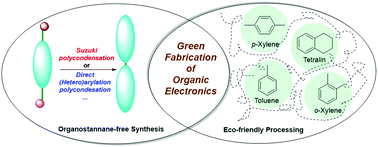Organostannane-free polycondensation and eco-friendly processing strategy for the design of semiconducting polymers in transistors
Abstract
Polymeric semiconductors have attracted a lot of attention in the field of organic field-effect transistors (OFETs) due to their potential application in solution-processable flexible electronics. In order to get high performance polymers that meet industry requirements, green polymerization methods and processing strategies are highly desired. Although organostannanes are highly efficient in polymerization, their toxic properties limit their application. For example, Suzuki–Miyaura crossing coupling was first suggested as a replacement of the Stille reaction for its environmentally benign nature of boron reagents. Moreover, direct (hetero)arylation polycondensation (DHAP) has been established as a straightforward method for the preparation of conjugated polymers. Additionally, aldol polycondensation was recently reported as a new route, as it requires neither organometallic monomers nor transition metal catalysts. For potential applications, not only is green synthesis needed, but also eco-friendly processing. In order to avoid the use of halogenated solvents, two major tactics are used: reducing intermolecular interactions and enhancing solute–solvent interactions. In this review, we aim to introduce green synthetic methods as well as environmentally benign processing strategies providing some ideas for the totally green fabrication of electronic devices.



 Please wait while we load your content...
Please wait while we load your content...